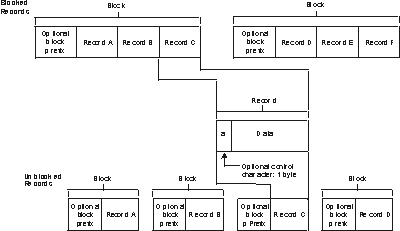For ISO/ANSI tapes, format-F records are the same as described in Fixed-Length Record Formats, except for control characters, block prefixes, and circumflex characters.
Control Characters. Control characters, when present, must be ISO/ANSI control characters. For more information about control characters see z/OS DFSMS Macro Instructions for Data Sets.
Block Prefixes. Record blocks can contain block prefixes. The block prefix can vary from 0 to 99 bytes, but the length must be constant for the data set being processed. For blocked records, the block prefix precedes the first logical record. For unblocked records, the block prefix precedes each logical record.
Using QSAM and BSAM to read records with block prefixes requires that you specify the BUFOFF parameter in the DCB. When using QSAM, you do not have access to the block prefix on input. When using BSAM, you must account for the block prefix on both input and output. When using either QSAM or BSAM, you must account for the length of the block prefix in the BLKSIZE and BUFL parameters of the DCB.
When you use BSAM on output records, the operating system does not recognize a block prefix. Therefore, if you want a block prefix, it must be part of your record. Note that you cannot include block prefixes in QSAM output records.
The block prefix can only contain EBCDIC characters that correspond to the 128, seven-bit ASCII characters. Thus, you must avoid using data types such as binary, packed decimal, and floating point that cannot always be converted into ASCII. This is also true when CCSIDs are used when writing to ISO/ANSI V4 tapes.
Related reading: For information about conversion routines supplied by the system for this type of conversion, which converts to ASCII 7-bit code, see z/OS DFSMS Using Magnetic Tapes.
Figure 1 shows the format of fixed-length records for ISO/ANSI tapes and where control characters and block prefixes are positioned if they exist.

Circumflex Characters. The GET routine tests each record (except the first) for all circumflex characters (X'5E'). If a record completely filled with circumflex characters is detected, QSAM ignores that record and the rest of the block. A fixed-length record must not consist of only circumflex characters. This restriction is necessary because circumflex characters are used to pad out a block of records when fewer than the maximum number of records are included in a block, and the block is not truncated.